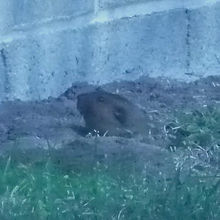| Mountain pocket gopher | |
|---|---|

| |
| Conservation status | |
 Least Concern (IUCN 3.1) | |
| Scientific classification | |
| Domain: | Eukaryota |
| Kingdom: | Animalia |
| Phylum: | Chordata |
| Class: | Mammalia |
| Order: | Rodentia |
| Family: | Geomyidae |
| Genus: | Thomomys |
| Species: | T. monticola |
| Binomial name | |
| Thomomys monticola J. A. Allen, 1893 | |
The mountain pocket gopher (Thomomys monticola) is a species of rodent in the family Geomyidae. It is endemic to California and Nevada. The Sierra Nevada are part of its range.
Characteristics

Mountain pocket gophers, as others in the genus Thomomys, have small ears, eyes, and fur-lined cheek pouches. They have short legs with large claws on their feet and smooth incisors. Mountain gophers tend to spend a majority of their time underground and are mostly active at night. They are about 27 centimeters long and 91 grams with brown or gray fur.
Habitat
The mountain pocket gopher naturally occurs on the edges of mountain meadows, wet meadows, and coastal prairies. Also dwelling in upward slopes of forests such as pine and fir, they create complicated tunnel systems in the friable soil of these forest floors. They will live and roam between 0.008 and 0.012 hectares, with tunnel systems anywhere from 200-2,000 square feet. These gophers prefer there to be vegetation above their tunnels and cause heaps of dirt to rise where they surface.
In summer, the gophers tunnel where the groundwater supply is about 4.3 feet below the surface. In winter, to avoid freezing, they will move higher to station underneath trees. When there are thick sheets of snow, mountain gophers will push cylinders of dirt from their burrows outward, leaving several above ground.
Diet
The mountain pocket gopher does not need water in its diet to survive, but instead extracts all its water from the food it consumes. They are herbivores whose primary food sources are forbs including whitethorn caenothus and gooseberry. They also have a preference towards lupine. Mountain pocket gophers will consume the roots and bulbs of these plants underground and store them in their tunnels. Pocket gophers rarely go aboveground to feed.
Reproduction
Typically the mountain pocket gopher mates during late spring and summer from May to July. They are mostly solitary other than mating. These gophers mate once a year in an underground nest and carry three to four in their litter.
References
- ^ Cassola, F. (2016). "Thomomys monticola". IUCN Red List of Threatened Species. 2016: e.T42596A22216069. doi:10.2305/IUCN.UK.2016-2.RLTS.T42596A22216069.en. Retrieved 11 November 2021.
- Ingles, Lloyd G. (1951). "Outline for an Ecological Life History of Pocket Gophers and Others Fossorial Mammals". Ecology. 32 (3): 537–544. doi:10.2307/1931730. ISSN 0012-9658.
- ^ Wilson, D.E. (1993). Mammal Species of the World: a Taxonomic and Geographic Reference (2nd ed.). Washington, D.C.: Smithsonian Institution Press.
- ^ Brylski, P. (1988–1990). "Mountain Pocket Gopher". California Wildlife Habitat Relationships System: 1.
- ^ Ingles, Lloyd G. (1949). "Ground Water and Snow as Factors Affecting the Seasonal Distribution of Pocket Gophers, Thomomys monticola". Journal of Mammalogy. 30 (4): 343–350. doi:10.2307/1375210. ISSN 0022-2372.
- Warren, Edward R. (1937). "Notes on Pocket Gophers". Journal of Mammalogy. 18 (4): 473–477. doi:10.2307/1374338. ISSN 0022-2372.
- Teipner, Cynthia Lea; Garton, Edward O.; Nelson, Jr., Lewis (September 1983). "Pocket Gophers in Forest Ecosystems" (PDF). United States Department of Agriculture: 7.
| Extant species of family Geomyidae (Pocket gophers) | |||||
|---|---|---|---|---|---|
| |||||
| Cratogeomys | |||||
| Geomys (Eastern pocket gophers) |
| ||||
| Heterogeomys | |||||
| Orthogeomys | |||||
| Pappogeomys | |||||
| Thomomys (Smooth-toothed pocket gophers) |
| ||||
| Zygogeomys | |||||
| Category | |||||